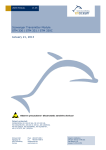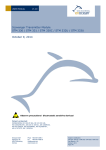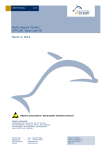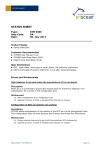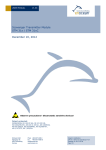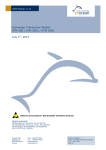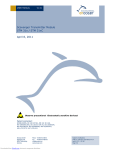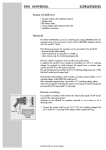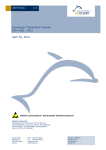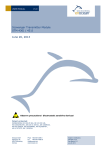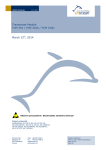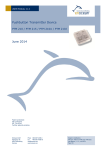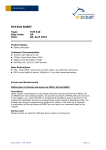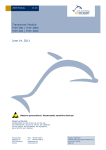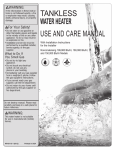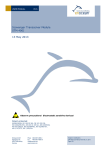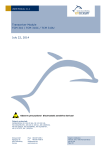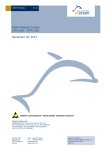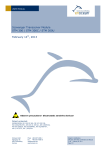Download User Manual Scavenger Transmitter Module STM 330 / STM 331
Transcript
USER MANUAL V1.30 Scavenger Transmitter Module STM 330 / STM 331 / STM 330C / STM 332U / STM 333U March 2, 2015 Observe precautions! Electrostatic sensitive devices! Patent protected: WO98/36395, DE 100 25 561, DE 101 50 128, WO 2004/051591, DE 103 01 678 A1, DE 10309334, WO 04/109236, WO 05/096482, WO 02/095707, US 6,747,573, US 7,019,241 EnOcean GmbH Kolpingring 18a 82041 Oberhaching Germany Phone +49.89.67 34 689-0 Fax +49.89.67 34 689-50 [email protected] www.enocean.com Subject to modifications STM 330 / STM 331 / STM 330C / STM 332U / STM 333U User Manual v1.30 March 2, 2015 Page 1/46 USER MANUAL V1.30 STM 330 / STM 331 / STM 330C / STM 332U / STM 333U REVISION HISTORY The following major modifications and improvements have been made to the first version of this document: No 0.55 0.90 0.91 0.95 0.99 1.00 1.01 1.02 1.03 1.04 1.05 1.10 1.15 1.20 1.30 Major Changes Initial version New drawings added; Agency certifications added; Charging circuitry modified; editorial changes Drawings updated Parameters of A/D converter corrected and specified in more detail; Charging circuitry modified. Pin for connection of backup battery changed; ICHAR modified in 2.4 and 2.5; section 3.5 inserted; drawings updated Block diagram and pin description modified. Table in 2.11 modified Remark added in 3.5; additional remarks in 2.11; label information modified in chapter 5; Shelf life added in 1.4; supply voltage for programming added in 2.2; Conducted output power replaced by radiated output power in 1.2; programming interface added in 2.3.2; other editorial changes Support for HSM 100 humidity sensor module added Specification of shelf life improved; figure added in 3.3.1; Chapter Related Documents added. STM 331 with helix antenna added (naming + helix antenna description), hints to update module via STMSEN Product variants STM 332U and STM 333U added Included PCB Drawings of STM 332U / STM 333U Added information on connector type Added advanced security information of firmware STM 330 / STM 331. Default manufacturer ID code is EnOcean. Published by EnOcean GmbH, Kolpingring 18a, 82041 Oberhaching, Germany www.enocean.com, [email protected], phone ++49 (89) 6734 6890 © EnOcean GmbH All Rights Reserved Important! This information describes the type of component and shall not be considered as assured characteristics. No responsibility is assumed for possible omissions or inaccuracies. Circuitry and specifications are subject to change without notice. For the latest product specifications, refer to the EnOcean website: http://www.enocean.com. As far as patents or other rights of third parties are concerned, liability is only assumed for modules, not for the described applications, processes and circuits. EnOcean does not assume responsibility for use of modules described and limits its liability to the replacement of modules determined to be defective due to workmanship. Devices or systems containing RF components must meet the essential requirements of the local legal authorities. The modules must not be used in any relation with equipment that supports, directly or indirectly, human health or life or with applications that can result in danger for people, animals or real value. Components of the modules are considered and should be disposed of as hazardous waste. Local government regulations are to be observed. Packing: Please use the recycling operators known to you. © 2015 EnOcean | www.enocean.com STM 330 / STM 331 / STM 330C / STM 332U / STM 333U User Manual v1.30 | Page 2/46 USER MANUAL V1.30 STM 330 / STM 331 / STM 330C / STM 332U / STM 333U TABLE OF CONTENT 1 RELATED DOCUMENTS ................................................................................... 5 2 GENERAL DESCRIPTION ................................................................................. 6 2.1 Basic functionality ......................................................................................... 6 2.2 Technical data............................................................................................... 8 2.3 Physical dimensions ....................................................................................... 8 2.3.1 Mechanical Outline – STM 330 / STM 331 / STM 330C .................................... 9 2.3.2 Mechanical Outline – STM 332U / STM 333U ............................................... 10 2.4 Environmental conditions.............................................................................. 11 2.5 Ordering Information ................................................................................... 11 3 FUNCTIONAL DESCRIPTION .......................................................................... 12 3.1 Simplified firmware flow chart ....................................................................... 12 3.2 Simplified device block diagram..................................................................... 13 3.3 Pin out ....................................................................................................... 14 3.4 Pin description and operational characteristics................................................. 15 3.4.1 GPIO supply voltage ................................................................................ 16 3.4.2 Analog and digital inputs .......................................................................... 17 3.4.3 Temperature sensor ................................................................................. 17 3.4.4 Programming Interface............................................................................. 18 3.5 Absolute maximum ratings (non operating) .................................................... 19 3.6 Maximum ratings (operating) ........................................................................ 19 3.7 Power management and voltage regulators .................................................... 19 3.8 Configuration .............................................................................................. 20 3.8.1 Configuration via pins .............................................................................. 20 3.8.2 Configuration via serial interface ............................................................... 21 3.9 Radio telegram............................................................................................ 23 3.9.1 Normal operation..................................................................................... 23 3.9.2 Teach-in telegram ................................................................................... 23 3.10 Secure radio telegram - STM 330 / STM 331 .............................................. 24 3.10.1 Switching between modes ........................................................................ 24 3.10.2 Enhances security telegram – STM 330 / STM 331 ....................................... 25 3.10.3 Security Teach-In – STM 330 / STM 331 ..................................................... 25 3.11 Transmit timing ...................................................................................... 25 3.11.1 Secure transmission timing ....................................................................... 25 3.12 Charging circuitry ................................................................................... 26 3.13 Energy consumption ............................................................................... 26 3.13.1 Consumption in enhanced security mode STM 330 / STM 331 ....................... 27 3.14 Storing the Rolling code counter in enhanced security operation – STM 330 / STM 331 .......................................................................................................... 28 APPLICATIONS INFORMATION....................................................................... 30 4.1 Using the WAKE pins.................................................................................... 30 4.2 Temperature sensor ..................................................................................... 31 4.3 Set point control and occupancy button .......................................................... 32 4.4 Combination with humidity sensor module HSM 100 ........................................ 32 4.5 Antenna layout............................................................................................ 33 4.5.1 Whip antenna (STM 330 / STM 330C / STM 332U) ....................................... 33 4.5.2 Helical antenna (STM 331 / STM 333U) ...................................................... 34 4.6 Mounting STM 33x into a housing .................................................................. 35 4.7 Transmission range ..................................................................................... 36 4 © 2015 EnOcean | www.enocean.com STM 330 / STM 331 / STM 330C / STM 332U / STM 333U User Manual v1.30 | Page 3/46 USER MANUAL V1.30 STM 330 / STM 331 / STM 330C / STM 332U / STM 333U 5 6 AGENCY CERTIFICATIONS ............................................................................ 37 5.1 CE Approval ................................................................................................ 37 5.2 FCC (United States) certification .................................................................... 38 5.2.1 STM 330C / 332U / 333U LIMITED MODULAR APPROVAL .............................. 38 5.2.2 STM 330C FCC Grant ............................................................................... 40 5.2.3 STM 332U / STM 333U FCC Grant .............................................................. 41 5.2.4 FCC Regulatory Statements ..................................................................... 42 5.3 IC (Industry Canada) certification .................................................................. 43 5.3.1 STM 330C IC Technical Approval Certificate ................................................ 44 5.3.2 STM 332U / STM 333U IC Technical Approval Certificate ............................... 45 5.3.3 Industry Canada Regulatory Statements..................................................... 46 Label Information ........................................................................................ 46 © 2015 EnOcean | www.enocean.com STM 330 / STM 331 / STM 330C / STM 332U / STM 333U User Manual v1.30 | Page 4/46 USER MANUAL V1.30 STM 330 / STM 331 / STM 330C / STM 332U / STM 333U 1 RELATED DOCUMENTS STM 33x products are available in several frequency, antenna and button position variants: STM 330 (868.3MHz, whip antenna, vertical oriented LRN button) STM 331 (868.3MHz, helical antenna, vertical oriented LRN button) STM 330C (315.0MHz, whip antenna, vertical oriented LRN button) STM 332U (902.875MHz, whip antenna, side oriented LRN button) STM 333U (902.875MHz, helical antenna, side oriented LRN button) This document describes operation of STM 330, STM 331, 330C, STM 332U, STM 333U modules with their built-in firmware. If you want to write own firmware running on the integrated micro controller or need more detailed information on the Dolphin core please also refer to Dolphin Core Description and Dolphin API Documentation at: http://www.enocean.com/en/knowledge-base/ If you want to connect other generic sensors to STM 33x (former STM 310 applications), you can download STEMSEN Software from following link: http://www.enocean.com/en/download/ Module can be programmed via EOP 300 programmer & EVA 330 developer board or EOP 350 programmer For mechanical integration please refer to our 3D drawings found at http://www.enocean.com/en/enocean_modules/stm-330/ If you want to add a humidity sensor please refer to the HSM 100 data sheet at http://www.enocean.com/en/enocean_modules/stm-330/ In addition we recommend following our application notes, in particular AN102: Antenna Basics – Basic Antenna Design Considerations for EnOcean based Products © 2015 EnOcean | www.enocean.com STM 330 / STM 331 / STM 330C / STM 332U / STM 333U User Manual v1.30 | Page 5/46 USER MANUAL V1.30 STM 330 / STM 331 / STM 330C / STM 332U / STM 333U 2 GENERAL DESCRIPTION 2.1 Basic functionality The extremely power saving RF transmitter module family STM 33x of EnOcean is optimized for realization of wireless and maintenance free temperature sensors, or room operating panels including set point dial and occupancy button. It requires only a minimum number of external components and provides an integrated and calibrated temperature sensor. Power supply is provided by a small pre-installed solar cell, an external energy harvester, or an external 3 V backup battery. An energy storage element is installed in order to bridge periods with no supply from the energy harvester. The module provides a user configurable cyclic wake up. After wake up, the internal microcontroller reads the status of the temperature sensor and optional set point dial. A radio telegram will be transmitted in case of a significant change of measured temperature or set point values or if the external occupancy button is pressed. In case of no relevant input change, a redundant retransmission signal is sent after a user configurable number of wake-ups to announce all current values. In addition to the cyclic wake-up, a wake up can be triggered externally using the input for the occupancy button or the internal LRN button. Additionally the STM 330 and STM 331 in 868 MHz include the enhanced secure mode. In enhanced secure mode the communication is protected by enhanced security features e.g. encryption. The modules can be switched from standard mode (without enhanced security) to enhanced mode and back by long press of LRN button also in field operation. The firmware can be configured to use different EEPs according to the availability set point dial and occupancy button. Features with built-in firmware Pre-installed solar cell On-board energy storage and charging circuit On-board LRN button On-board TX indicator LED Calibrated internal temperature sensor On board connector for external occupancy button and set point dial input Configurable wake-up and transmission cycle Wake-up via Wake pins or LRN button Support for humidity sensor module HSM 100 Communication protected by enhanced security features – STM 320 / STM 329 Features accessible via API Using the Dolphin API library it is possible to write custom firmware for the module. The API provides: Integrated 16 MHz 8051 CPU with 32 kB FLASH and 2 kB SRAM Integrated temperature sensor Various power down and sleep modes down to typ. 0.2 µA current consumption © 2015 EnOcean | www.enocean.com STM 330 / STM 331 / STM 330C / STM 332U / STM 333U User Manual v1.30 | Page 6/46 USER MANUAL V1.30 STM 330 / STM 331 / STM 330C / STM 332U / STM 333U Up to 13 configurable I/Os 10 bit ADC, 8 bit DAC © 2015 EnOcean | www.enocean.com STM 330 / STM 331 / STM 330C / STM 332U / STM 333U User Manual v1.30 | Page 7/46 USER MANUAL V1.30 STM 330 / STM 331 / STM 330C / STM 332U / STM 333U 2.2 Technical data Antenna whip antenna (STM 330 / STM 330C / STM 332U) helical antenna (STM 331, STM 333U) Frequency Radio Standard Data rate/Modulation type Radiated Output Power 315.0 MHz (STM 330C) / 868.3 MHz (STM 330 / STM 331) / 902.875MHz ( STM 332U / STM 333U) EnOcean 902 MHz / 868 MHz / 315 MHz 125 kbps/ASK(868MHz/315MHz), FSK(902MHz) STM 330: +8 dBm1 (EIRP) ± 2.5 dB2 STM 331: +5 dBm1 (EIRP) ± 2.5 dB2 STM 330C: +92 dBµV/m1 ± 2 dB2 STM 332U: +101 dBµV/m1 ± 2 dB2 STM 333U: +99 dBµV/m1 ± 2 dB2 Power Supply @ VDD Pre-installed solar cell Illumination 50-100000 lux 2.1 V–5.0 V, 2.6 V needed for start-up typ. 4 days, min. 60 hours Initial operation time in darkness @ 25°C if energy storage fully charged, wake-up every 100 s, 3 transmission of telegram every 1000 s on average Operation start up time with empty energy store Input Channels typ. 2.5 min @ 400 lux / 25 °C incandescent or fluorescent light Internal: temperature sensor, LRN button External: occupancy button, set point dial, HSM 100 Temperature sensor Measurement range 0-40 °C, resolution 0.16 K Accuracy typ. ±0.5 K between 17 °C and 27 °C typ. ±1 K between 0 °C and 40 °C configurable EEPs: A5-02-05 (default), A5-02-30, A5-10-05, A5-10-03 and with HSM 100: A5-04-01, A5-10-10, A5-10-12 20 pins, grid 1.27 mm, □ 0.4 mm R&TTE EN 300 220 (STM 330 / 331) FCC CFR-47 Part 15 (STM 330C, STM 332U / 333U) EnOcean Equipment Profiles Connector Radio Regulations Encryption Algorithms 2.3 VAES 128, CMAC – STM 330 / STM 331 Physical dimensions PCB dimensions 43±0.2 x 16±0.3 x 1±0.1 mm Module height Weight 8 mm 4.5 g (STM 33x), 4.9 g (STM 330C), 4.5 g (STM 332U), 4.5 g (STM 333U) 1 Measured in test laboratory, measurement uncertainty 2.7 dB 2 Tolerance of measurement in production at 50 Ω 3 Full performance of the PAS614L energy storage is achieved after several days of operation (up to two weeks) at good illumination level. Performance degrades over life time, especially if energy storage is exposed to higher temperatures. Each 10 K drop in temperature doubles the expected life span. © 2015 EnOcean | www.enocean.com STM 330 / STM 331 / STM 330C / STM 332U / STM 333U User Manual v1.30 | Page 8/46 USER MANUAL V1.30 STM 330 / STM 331 / STM 330C / STM 332U / STM 333U 2.3.1 Mechanical Outline – STM 330 / STM 331 / STM 330C © 2015 EnOcean | www.enocean.com STM 330 / STM 331 / STM 330C / STM 332U / STM 333U User Manual v1.30 | Page 9/46 USER MANUAL V1.30 STM 330 / STM 331 / STM 330C / STM 332U / STM 333U 2.3.2 Mechanical Outline – STM 332U / STM 333U © 2015 EnOcean | www.enocean.com STM 330 / STM 331 / STM 330C / STM 332U / STM 333U User Manual v1.30 | Page 10/46 USER MANUAL V1.30 STM 330 / STM 331 / STM 330C / STM 332U / STM 333U 2.4 Environmental conditions Operating temperature -20 °C … +60 °C -20 °C … +60 °C, recommended4: +10 °C…+30 °C, <60%r.h. Storage temperature 36 months after delivery5 Shelf life (in absolute darkness) Humidity 0% … 93% r.h., non-condensing The module shall not be placed on conductive materials, to prevent discharge of the internal energy storages5. Even materials such as conductive foam (ESD protection) may have negative impact. 2.5 Ordering Information Type STM 330 STM 331 STM 330C STM 332U STM 333U Ordering Code S3001-D330 S3001-D331 S3031-D330 S3051-D332 S3051-D333 Frequency 868.3 MHz 868.3 MHz 315.0 MHz 902.875 MHz 902.875 MHz Note Supports Enhanced security. Supports Enhanced security. 4 Recommended for maximum life of energy storage capacitor Deep discharge of the PAS614L energy storage leads to degradation of performance. Therefore products have to be taken into operation after 36 months. At least the PAS614L needs to be recharged to 2.1 V. 5 © 2015 EnOcean | www.enocean.com STM 330 / STM 331 / STM 330C / STM 332U / STM 333U User Manual v1.30 | Page 11/46 USER MANUAL V1.30 STM 330 / STM 331 / STM 330C / STM 332U / STM 333U 3 FUNCTIONAL DESCRIPTION 3.1 Simplified firmware flow chart © 2015 EnOcean | www.enocean.com STM 330 / STM 331 / STM 330C / STM 332U / STM 333U User Manual v1.30 | Page 12/46 USER MANUAL V1.30 STM 330 / STM 331 / STM 330C / STM 332U / STM 333U 3.2 Simplified device block diagram VCHAR VDD Whip or helical antenna BALUN 16MHz Oscillator DOLPHIN EO3000I UVDDext OCC LRN Power management RF Transmitter 868.3 MHz (STM 33x) 315.0 MHz (STM 330C) 902.875 MHz (STM 33xU) Micro Controller Spontaneous wake-up Transmit Indicator HSM LRN button CW_1 CW_0 Cyclic Wake-up (every 1 s ,10 s , 100 s, or SW defined) (every 100th, every 10th, every cyclic wake-up or SW defined) RESET A/D SET Energy Storage Solar Cell VGC © 2015 EnOcean | www.enocean.com SWPWR Presence Signal GND CP_0 CP_1 STM 330 / STM 331 / STM 330C / STM 332U / STM 333U User Manual v1.30 | Page 13/46 USER MANUAL V1.30 STM 330 / STM 331 / STM 330C / STM 332U / STM 333U 3.3 Pin out Energy Store 1 LED LRN The figure above shows the pin out and location of the extension connector provided by STM 33x modules. The connector pins are named according to the naming of the EO3000I chip to simplify usage of the DOLPHIN API. The connector type is Samtec FTSH-110-01-L-DV-P-TR or a functional equivalent. Please refer to Samtec for detailed drawings and recommendation about suitable mating connectors as needed. The table in section 3.4 shows the translation of hardware pins to a naming that fits the functionality of the built-in firmware. © 2015 EnOcean | www.enocean.com STM 330 / STM 331 / STM 330C / STM 332U / STM 333U User Manual v1.30 | Page 14/46 USER MANUAL V1.30 STM 330 / STM 331 / STM 330C / STM 332U / STM 333U 3.4 Pin description and operational characteristics STM 33x Hardware Symbol GND VDD STM 33x Function Characteristics Firmware Symbol GND Ground connection VDD Supply voltage 2.1 V – 5.0 V; Start-up voltage: 2.6 V Maximum ripple: see 3.7 Not available at pin header. Supply for proRecommended supply voltage for gramming I/F programming 3V VCHAR VCHAR Charging input Input for an external energy harvester or a battery. See 0. Supply for proRecommended supply voltage for gramming I/F if programming 3.3V – 3.6 V VDD cannot be used.6 VGC VGC Voltage Gold Cap Connection of additional external energy storage possible. See 0. SWPWR SWPWR DVDD supply volt- 1.8 V. Output current: max. 5 mA. (= switched age regulator out- Supply for external circuitry, available DVDD of put switched via while not in deep sleep mode. SWPWR is EO3000I) transistor conswitched on 0.25 ms before sampling of trolled by EO3000I inputs and is switched off afterwards. ADIO5 pin. UVDDext UVDDext Ultra low power Not for supply of external circuitry! (=UVDD of supply voltage For use with WAKE pins only, see section EO3000I regulator output 4.1. Limited to max. 1 µA output current with 1.8MΩ by internal 1.8 MΩ resistor! in series) IOVDD (not available at pin connector) RESET IOVDD GPIO supply voltage Internal connection to EO3000I DVDD (typ. 1.8 V) See 3.4.1 RESET PROG_EN PROG_EN Reset input Programming I/F Programming I/F ADIO0 SET Analog input Active high reset (1.8 V) Fixed internal 10 kΩ pull-down. HIGH: programming mode active LOW: operating mode Digital input, fixed internal 10 kΩ pulldown. For connection of an external set point dial. See 4.3 Internal pull-up; do not connect Internal pull-up; do not connect ADIO1 ADIO2 Not used Not used 6 E.g. if module shall be programmed or configured via pin connector. If a bed of nails fixture for programming is available VDD should be used instead of VCHAR. © 2015 EnOcean | www.enocean.com STM 330 / STM 331 / STM 330C / STM 332U / STM 333U User Manual v1.30 | Page 15/46 USER MANUAL V1.30 STM 330 / STM 331 / STM 330C / STM 332U / STM 333U ADIO3 HSM ADIO4 ADIO6 ADIO7 Input for HSM 100 Not used Not used Programming I/F SCSEDIO0 CW_1 Encoding input for wake-up cycle SCLKDIO1 CW_0 Programming I/F Encoding input for wake-up cycle WSDADIO2 CP_1 Programming I/F Encoding input for retransmission RSDADIO3 CP_0 Programming I/F Encoding input for retransmission WAKE0 OCC Programming I/F Wake input WAKE1 LRN LRN input Internal pull-up; leave open or connect HSM 100 Internal pull-up; do not connect Internal pull-up; do not connect Leave open Configuration interface. Leave open or connect to GND. See 3.8.1. Internal pull-up Configuration interface. Leave open or connect to GND. See 3.8.1. Internal pull-up Configuration interface. Leave open or connect to GND. See 3.8.1. Internal pull-up Configuration interface. Leave open or connect to GND. See 3.8.1. Internal pull-up Input for external occupancy button. Change of logic state leads to wake-up and transmission of a telegram if correct EEP selected. See 3.8.2. Must be connected to UVDDext or GND! At time of delivery WAKE0 is connected to UVDDext via a jumper at the connector. See also 4.1. Press (HIGH to LOW) transmission of teach-in telegram. Long press (typ. 10 sek in LOW) leads to mode change. – STM 330 / STM 331. Internal pull-up to UVDD. See also 3.9 and 4.1. 3.4.1 GPIO supply voltage The IOVDD pin of EO3000I is internally connected to DVDD. For digital communication with other circuitry therefore a voltage of 1.8 V has to be used. While the module is in deep sleep mode the microcontroller with all its peripherals is switched off and DVDD, IOVDD, and SWPWR are not supplied. If DVDD=0 V and IOVDD is not supplied (e.g. while in sleep mode), do not apply voltage to ADIO0 to ADIO7 and the pins of the serial interface (SCSEDIO0, SCLKDIO1, WSDADIO2, RSDADIO3). This may lead to unpredictable malfunction of the device. © 2015 EnOcean | www.enocean.com STM 330 / STM 331 / STM 330C / STM 332U / STM 333U User Manual v1.30 | Page 16/46 USER MANUAL V1.30 STM 330 / STM 331 / STM 330C / STM 332U / STM 333U For I/O pins configured as analog pins the IOVDD voltage level is not relevant! See also 3.4.2. IOVDD If configured as digital I/O ADIO0 ADIO1 ADIO2 ADIO3 ADIO4 ADIO5 ADIO6 ADIO7 SCSEDIO0 SCLKDIO1 WSDADIO2 RSDADIO3 3.4.2 Analog and digital inputs Parameter Analog Input Mode Conditions / Notes Single ended Measurement range Min 0.07 0x00 Input coupling Input capacitance Parameter Digital Input Mode Units V DC Single ended against GND @ 1 kHz Single ended against GND @ 1 kHz Conditions / Notes 10 M 10 Min Typ Max 2/3 IOVDD Input HIGH voltage @IOVDD=1.7 … 1.9 V 90 pF Units V Input LOW voltage Pull up resistor Max RVDD0.07 0xFF Internal reference RVDD/2 Interpreted as7 Input impedance Typ 132 1/3 IOVDD 200 V k 3.4.3 Temperature sensor Parameter Measurement range Accuracy 7 Conditions / Notes 17 - 27 °C 0 – 40 Min 0 Typ 0.5 1 Max 40 Units °C K K For measurement of set point with external set point dial © 2015 EnOcean | www.enocean.com STM 330 / STM 331 / STM 330C / STM 332U / STM 333U User Manual v1.30 | Page 17/46 USER MANUAL V1.30 STM 330 / STM 331 / STM 330C / STM 332U / STM 333U 3.4.4 Programming Interface The positions of the pads needed for programming are shown in the layout below. Data are available from EnOcean as Gerber files (STM3XY(C)_05.GTL and STM3XY(C)_05.GK0). Number Symbol 1 2 3 4 5 6 7 8 9 10 VDD GND PROG_EN RESET SCSEDIO0 SCLKDIO1 WSDADIO2 RSDADIO3 ADIO7 ADIO6 Only if in addition to programming I/F a serial interface is needed Top layer If VDD is not accessible, e.g. because the module shall be programmed via the pin connector, please use VCHAR instead of VDD (see 0). © 2015 EnOcean | www.enocean.com STM 330 / STM 331 / STM 330C / STM 332U / STM 333U User Manual v1.30 | Page 18/46 USER MANUAL V1.30 STM 330 / STM 331 / STM 330C / STM 332U / STM 333U 3.5 Absolute maximum ratings (non operating) Symbol VDD VGC VCHAR ICHAR GND VINA VIND 3.6 ICHAR 3.7 Min -0.5 1.5 0 0 -0.5 -0.5 Max 5.5 3.3 6 45 0 2 3.6 Units V V V mA V V V Max 5.0 3.3 6 Units V V V Maximum ratings (operating) Symbol VDD VGC VCHAR GND VINA VIND Parameter Supply voltage at VDD Voltage gold cap Supply voltage from external energy harvester Supply current from external energy harvester Ground connection Voltage at every analog input pin Voltage at RESET, WAKE0/1, and every digital input Parameter Min Supply voltage at VDD and VDDLIM 2.1 Voltage gold cap 1.5 Supply voltage from external energy harvester 0 Supply current from external energy harvester VCHAR<4 V 4 V<VCHAR<6 V Ground connection Voltage at every analog input pin Voltage at RESET, WAKE0/1, and every digital input Limited internally 45 0 2.0 3.6 0 0 0 mA V V V Power management and voltage regulators Symbol Parameter Conditions / Notes Voltage Regulators Ripple on VDD, where VDDR Min(VDD) > VON UVDD Ultra Low Power supply RVDD RF supply Internal signal only DVDD Digital supply Internal signal only Threshold Detector VON Turn on threshold Automatic shutdown if VOFF Turn off threshold VDD drops below VOFF Min Typ Max Units 50 mVpp 1.7 1.7 1.8 1.8 1.8 1.9 1.9 V V V 2.3 1.85 2.45 1.9 2.6 2.1 V V Threshold detector STM 33x provides an internal ultra low power ON/OFF threshold detector. If VDD > VON, it turns on the ultra low power regulator (UVDD), the watchdog timer and the WAKE# pins circuitry. If VDD ≤ VOFF, it initiates the automatic shut down of STM 33x. For details of this mechanism please refer to the Dolphin Core Description documentation. © 2015 EnOcean | www.enocean.com STM 330 / STM 331 / STM 330C / STM 332U / STM 333U User Manual v1.30 | Page 19/46 USER MANUAL V1.30 STM 330 / STM 331 / STM 330C / STM 332U / STM 333U 3.8 Configuration 3.8.1 Configuration via pins The encoding input pins have to be left open or connected to GND in correspondence with the following connection schemes. These settings are checked at every wake-up. Wake-up cycle time CW_0 CW_1 Wake-up cycle time NC GND 1 s ±20% GND NC 10 s ±20% NC NC 100 s ±20% GND GND No cyclic wake-up Redundant retransmission Via CP_0 and CP_1 an internal counter is set which is decreased at every wake-up signal. Once the counter reaches zero the redundant retransmission signal is sent. CP_0 CP_1 GND NC Number of wake-ups that trigger a redundant retransmission Every timer wake-up signal NC NC Every 7th - 14th timer wake-up signal, affected at random NC GND Every 70th - 140th timer wake-up signal, affected at random GND GND No redundant retransmission A radio telegram is always transmitted after wake-up via WAKE pins! After transmission the counter is reset to a random value within the specified interval. According to FCC 15.231a) a redundant retransmission at every timer wake-up to determine the system integrity is only allowed in safety and security applications! In this case the total transmission time must not exceed two seconds per hour, which means that a combination with a 1 s wake-up cycle time is not allowed! If applied in other (non-safety, non-security) applications a minimum of 10 s between periodic transmissions is required. In addition the device has to comply with the lower field strength limits of 15.231e). The limited modular approval of STM 330C / 332U / 333U is not valid in this case. © 2015 EnOcean | www.enocean.com STM 330 / STM 331 / STM 330C / STM 332U / STM 333U User Manual v1.30 | Page 20/46 USER MANUAL V1.30 STM 330 / STM 331 / STM 330C / STM 332U / STM 333U 3.8.2 Configuration via serial interface Via the programming interface the configuration area can be modified. This provides a lot more configuration options. Values set via serial interface override hardware settings! These settings are read after RESET or power-on reset only and not at every wake-up of the module! Parameter Configuration via pins See section 3.8.1 Configuration via serial interface Value can be set from 1 s to 65534 s Redundant Retransmission cycle See section 3.8.1 Min…Max values for random interval If Min=Max -> random switched off Threshold values for inputs No The default values are: Temperature measurement: ±0.5 K Set point measurement: ±10 digits No Every change of a wake pin triggers a wake-up. For both wake pins it can be configured individually if a telegram shall be sent on rising, falling or both edges. On STM 330 / STM 331 only the wake1 pin can be configured. The wake0 behaviour is fixed due to mode switch between secure and enhanced mode. Wake up cycle (transmission of telegram if threshold value exceeded) Edge of wake pin change causing a telegram transmission Manufacturer ID and EEP No (EnOcean Equipment Profile) Information about manufacturer and type of device. This feature is needed for “automatic” interoperability of sensors and actuators or bus systems. Unique manufacturer IDs are distributed by the EnOcean Alliance. The interface is shown in the figure below: GND USB Dolphin Studio, or EOP USB <= > SPI interface SPI VDD Reset PROG_EN ADIO7 SCSEDIO0 SCLKDIO1 WSDADIO2 RSDADIO3 STM 330 EnOcean provides EOPx (EnOcean Programmer, a command line program) and Dolphin Studio (Windows application for chip configuration, programming, and testing) and the USB/SPI programmer device as part of the EDK 300 or EDK 350 developer´s kit. The configuration page of DolphinStudio is shown in the figure below. © 2015 EnOcean | www.enocean.com STM 330 / STM 331 / STM 330C / STM 332U / STM 333U User Manual v1.30 | Page 21/46 USER MANUAL V1.30 STM 330 / STM 331 / STM 330C / STM 332U / STM 333U Please select STM 33x and press “Read configuration” button before modifying the entries! © 2015 EnOcean | www.enocean.com STM 330 / STM 331 / STM 330C / STM 332U / STM 333U User Manual v1.30 | Page 22/46 USER MANUAL V1.30 STM 330 / STM 331 / STM 330C / STM 332U / STM 333U Due to security features additional parameters apply for STM 330 / STM 331. Parameter Enable mode change to secure mode. Configuration via programming interface Default value is enabled. By configuration it can be disabled so the module will not be able to enter the secure mode. CMAC Length CMAC length 3 bytes or 4 bytes. Private Key AES 128 key which is used for data encryption. Subkey 1 Subkey derivated from private key. Subkey 2 Subkey derivated from private key. Set initial RLC Initial value of the RLC. Please refer to the EnOcean Security Specification for details http://www.enocean.com/en/security-specification/. 3.9 Radio telegram 3.9.1 Normal operation In normal operation STM 33x transmits telegram data according to the selected EEP (EnOcean Equipment Profile). For details please refer to the EnOcean Equipment Profiles specification. (http://www.enocean-alliance.org/eep/) 3.9.2 Teach-in telegram In case of a wake-up via WAKE1 pin (LRN input) the module transmits a teach-in telegram. If the manufacturer code is not set, the module transmits a normal telegram according to 3.9.1 with the difference that DI_3=0. If a Manufacturer ID is set, this teach-in telegram contains special information as described below. By default EnOcean Manufacturer ID is set. Customer can configure their own. With this special teach-in telegram it is possible to identify the manufacturer of a device and the function and type of a device. The following EnOcean Equipment Profiles are supported by STM 33x. They have to be selected according to the availability of external occupancy button and set point control by the method described in 3.8.2: A5-02-05 A5-02-30 A5-10-03 A5-10-05 Temperature Temperature Temperature Temperature sensor sensor sensor sensor 0-40 °C (default) -20 – 62,3 °C 0-40 °C, set point control 0-40 °C, set point, and occupancy control If a HSM 100 module is plugged onto the connector in addition the following EEPs are supported: A5-04-01 Temperature and humidity sensor 0-40 °C and 0-100% r.h. A5-10-10 Temperature and humidity sensor 0-40 °C and 0-100% r.h., set point control, and occupancy control A5-10-12 Temperature and humidity sensor 0-40 °C and 0-100% r.h., set point control © 2015 EnOcean | www.enocean.com STM 330 / STM 331 / STM 330C / STM 332U / STM 333U User Manual v1.30 | Page 23/46 USER MANUAL V1.30 STM 330 / STM 331 / STM 330C / STM 332U / STM 333U For details please refer to the EnOcean Equipment Profiles specification. (http://www.enocean-alliance.org/eep/) 3.10 Secure radio telegram - STM 330 / STM 331 The STM 330 / STM 331 can be operated in: 3.10.1 Standard mode – no enhanced security is used. This is the common operation mode, originally available. This is also the default factory mode. Security mode – communication is protected by enhanced security features. This mode was added later in module evolution. Switching between modes STM 330 / STM 331 can be switched from normal mode to secure mode and vice versa by long press of the LRN Button (Wake 1). The behaviour of the LRN button is following: 1. Button is pressed – LED flashes briefly Teach-in is performed according to the actual mode. 2. Button is hold a. If released in period < 10 seconds then actual mode is kept. No further action. b. If hold for at least 10 seconds then the actual mode is changed (standard -> secure or secure -> standard). LED flashes briefly. Teach-in is performed according to the actual (new) mode. 3. Button is released – no action. Upon entry into secure mode, a secure teach-in telegram is sent by STM 330 / STM 331. Please see Chapter 3.10.3 for details. Mode change features can be suppressed by configuration flag. If flag set module will not enter secure mode after long press, but stay in standard mode. By default mode change feature is enabled. Before changing the operating mode please make sure to clear the device from all receivers which have been taught to work with this device before. Otherwise the receiver will ignore the telegrams and the application will not work. The flag for actual mode itself is stored in non-volatile memory. After power down reset the previous selected mode is active. Therefore mode change is limited to 50 times. In normal application scenario only very few are required. The factory delivery mode of the STM 330 / STM 331 is standard – not encrypted. This mode is common mode originally available. Secure mode was added in later product upgrades. The mode change feature can be suppressed by a configuration parameter. By default mode change is enabled. For details on configuration please see chapter 3.8.2 © 2015 EnOcean | www.enocean.com STM 330 / STM 331 / STM 330C / STM 332U / STM 333U User Manual v1.30 | Page 24/46 USER MANUAL V1.30 STM 330 / STM 331 / STM 330C / STM 332U / STM 333U 3.10.2 Enhances security telegram – STM 330 / STM 331 In secure mode of STM 330 / STM 331 the payload content of the telegram is always protected with advanced security features. Normal operation telegram payload and also Teachin telegram payload are protected in the same way. The security features used are defined by the Security Level format - SLF. This parameter is set by default to the highest possible level: 24-bit RLC, No RLC TX 4-byte CMAC, VAES encryption The security features are added to the communication by encapsulating the payload and Teach-in telegram payload into a secured telegram. The payload itself is not changed and corresponds to the standard mode payload like defined in chapter 3.9.1. Please refer to the EnOcean Security Specification for details http://www.enocean.com/en/security-specification/. 3.10.3 Security Teach-In – STM 330 / STM 331 To process security communication on a receiver the STM 330 / STM 331 has to send a security teach-in telegram to the receiver and so inform him about the used security profile, AES key and initial RLC counter. The security teach-in has to take place before any other communication can be executed (profile teach-in included). Press the LRN button to trigger the transmission of the teach-in telegram. The security teach-in and then the profile teachin are transmitted. The profile teach-in telegram is already protected by advanced security features. Profile teach-in telegram corresponds to the telegram defined in chapter 3.9.2. The behaviour of the LRN button is following: 1. Button is pressed 2. Security teach-in is send. 3. Profile teach-in is send. For more information on the structure of the teach-in telegram please refer to chapter 4.2 of http://www.enocean.com/en/security-specification/. 3.11 Transmit timing The setup of the transmission timing allows avoiding possible collisions with data packages of other EnOcean transmitters as well as disturbances from the environment. With each default transmission cycle, 3 identical sub-telegrams are transmitted within 40ms. Transmission of a sub-telegram lasts approximately 1.2ms. The delay between the three transmission bursts is affected at random. 3.11.1 Secure transmission timing In secure mode of STM 330 and STM 331 the transmission cycle includes 2 identical subtelegrams are transmitted within 20 ms. This is required to compensate the additional energy requirement of enhanced security computing and additional payload. The transmission of a enhanced secure subtelegram lasts approximately 1.6 ms. © 2015 EnOcean | www.enocean.com STM 330 / STM 331 / STM 330C / STM 332U / STM 333U User Manual v1.30 | Page 25/46 USER MANUAL V1.30 STM 330 / STM 331 / STM 330C / STM 332U / STM 333U 3.12 Charging circuitry The figure below shows the internal charging circuit. It is controlled via the WXODIO pin of EO3000I which switches according to the status of the internal threshold detector. For details please refer to our Dolphin Core Description documentation. The WXIDIO pin is used to disconnect the goldcap at voltages below VOFF to avoid deep discharge. An external 3 V backup battery can be connected at VCHAR. 3.13 Energy consumption 100 10 Current [mA] 1 0.1 0.01 0.001 0.0001 0.00001 0 10 20 30 40 50 60 70 80 90 100 Time [ms] Current Consumption of STM 33x Charge needed for one measurement and transmit cycle: ~130 µC Charge needed for one measurement cycle without transmit: ~30 µC (current for external sensor circuits not included) © 2015 EnOcean | www.enocean.com STM 330 / STM 331 / STM 330C / STM 332U / STM 333U User Manual v1.30 | Page 26/46 USER MANUAL V1.30 STM 330 / STM 331 / STM 330C / STM 332U / STM 333U Calculations are performed on the basis of electric charges because of the internal linear voltage regulator of the module. Energy consumption varies with voltage of the energy storage while consumption of electric charge is constant. From these values the following typical performance parameters at room temperature have been calculated: Wake cycle [s] 1 1 1 10 10 10 100 100 100 Operation Time in darkness [h] Transmit when storage interval fully charged 1 10 100 1 10 100 1 10 100 0.5 1.7 2.1 5.1 16 20 43 98 112 Required reload time [h] at 200 lux within 24 h for continuous operation Current Illuminain µA 24 h operation tion level required after 6 h in lux for for conillumination continuous tinuous at x lux operation operation storage too small storage too small storage too small storage too small 21 16.8 7.8 3.6 3 storage too small storage too small storage too small storage too small storage too small storage too small 260 120 100 5220 1620 1250 540 175 140 65 30 25 130.5 40.5 31.3 13.5 4.4 3.5 1.6 0.8 0.6 Assumptions: Internal storage PAS614L-VL3 (after several days of operation at good illumination level) with 0.25 F, Umax=3.2 V, Umin=2.2 V, T=25 °C Consumption: Transmit cycle 100 µC, measurement cycle 30 µC Pre-installed solar cell ECS 300, operating values 3 V and 5 µA @ 200 lux fluorescent light Current proportional to illumination level (not true at very low levels!) These values are calculated, the accuracy is about +/-20%! The performance varies over temperature and may be strongly reduced at extreme temperatures or short transmit intervals. 3.13.1 Consumption in enhanced security mode STM 330 / STM 331 Enhanced security mode requires more energy due to encryption algorithm computing time and extended telegram length because of CMAC. This added consumption is compensated by reducing the subtelegram count to 2. With this measure the operation in dark time is even little bit increased. There it is to assume the operation in dark time is not reduced by using enhanced security. © 2015 EnOcean | www.enocean.com STM 330 / STM 331 / STM 330C / STM 332U / STM 333U User Manual v1.30 | Page 27/46 USER MANUAL V1.30 STM 330 / STM 331 / STM 330C / STM 332U / STM 333U 3.14 Storing the Rolling code counter in enhanced security operation – STM 330 / STM 331 For the enhanced security features a RLC Counter needs to be stored in non-volatile memory. For security reasons the RLC Counter is incremented by every transmitted telegram. Together with the CMAC the RLC ensures that messages cannot be reproduced or forged. In STM 330 / STM 331 the RLC is stored in the Dolphin chip flash memory. To improve the endurance of the flash memory and also the energy budget not every increment is saved to the non-volatile flash memory. During deep sleep the RLC is stored in RAM0 memory. The RLC storing algorithm is described in the following text. Constrains Writing a RLC (4bytes) into flash is not energy consuming. It is fast (μSec)and requires almost no extra energy. Erasing a flash page is energy consuming operation. It takes 40ms and requires extra energy. For details on energy consumption for flash operation please see the Dolphin Chip Core specification. https://www.enocean.com/dolphin-core-description/ Strategy We implement a ring buffer which consist of multiple (16) pages The RLCs are written sequentially to the current page When the page is full we move to the next page When almost all pages are full, we erase the oldest page Diagram Legend Free page Partially written page Full page Pointer to the current page and direction how the rolling codes are written Pointer to the last/oldest page and direction how the flash pages are erased © 2015 EnOcean | www.enocean.com STM 330 / STM 331 / STM 330C / STM 332U / STM 333U User Manual v1.30 | Page 28/46 USER MANUAL V1.30 STM 330 / STM 331 / STM 330C / STM 332U / STM 333U First rolling code is written to flash Several pages are full Almost all flash were full, we deleted the first page Because the flash pages act as a ring buffer, this situation is also normal Definitions RLC - 32-bit counter value used for encryption and authentication. After a data telegram is send it is incremented by 1. RLCram0 - RLC value saved in RAM0. It contains the actual RLC value RLCflash - RLC value saved in flash. This value is older or the same as RLCram0 ΔRLC = RLCram0 - RLCflash . The difference between the RLCflash value saved in flash, and the current RLCram0 saved in RAM0. RLCSAVE-WINDOW is fixed to 30. Vcc - actual supply voltage [V] Von - voltage required to switch the chip ON after it was in OFF state. Voff - under this voltage the chip is switched off, RAM and RAM0 data are lost. Constrains We assume that the voltage will not drop from about Von to under Voff It has to be assured by HW and SW that any operation e.g. sending a telegram or erasing a flash page will not cause to drop the voltage from Von to under Voff Rules If Vcc > Von then increment the RLCram0 after the data telegram has been sent saving to flash is not needed If Vcc < Von and ΔRLC > RLCSAVE-WINDOW then the RLCram0 has to be saved to flash and RLCflash = RLCram0 send data telegram and increment RLCram0 If Vcc > 2.8V and flash memory is almost full then erase a flash page and go to deepsleep don't send any telegram - this would required even more energy, and the chip would probably switch off After the chip starts from power down read RLCflash from flash and set RLCram0 = RLCflash + RLCSAVE-WINDOW © 2015 EnOcean | www.enocean.com STM 330 / STM 331 / STM 330C / STM 332U / STM 333U User Manual v1.30 | Page 29/46 USER MANUAL V1.30 STM 330 / STM 331 / STM 330C / STM 332U / STM 333U Example Diagram 3 2,4 Voltage 1,8 RLC Changed 1,2 RLC Saved 0,6 Von Voff 0 0 2 4 6 8 10 12 For the illustration we set RLCSAVE-WINDOW equal to 4 4 APPLICATIONS INFORMATION 4.1 Using the WAKE pins The logic input circuits of the WAKE0 and WAKE1 pins are supplied by UVDD and therefore also usable in “Deep Sleep Mode”. Due to current minimization there is no internal pull-up or pull-down at the WAKE pins. When STM 33x is in “Deep Sleep Mode” and the logic levels of WAKE0 and / or WAKE1 is changed, STM 33x starts up. As the there is no internal pull-up or pull-down at the WAKE0 pin, it has to be ensured by external circuitry, that the WAKE0 pin is at a defined logic level at any time. At time of delivery a jumper is connected between WAKE0 and UVDDext. WAKE1 provides an internal 1.8 MΩ pull-up. See figure below. © 2015 EnOcean | www.enocean.com STM 330 / STM 331 / STM 330C / STM 332U / STM 333U User Manual v1.30 | Page 30/46 USER MANUAL V1.30 STM 330 / STM 331 / STM 330C / STM 332U / STM 333U WAKE1 UVDD WAKE0 EO3000I 1M8 WAKE1 LRN Button GND 1M8 UVDDext WAKE0 STM 33x Jum per installed at tim e of delivery When the LRN button is pressed WAKE1 is pulled to GND and a teach-in telegram is transmitted or mode change is executed. As long as the button is pressed a small current of approximately 1 µA is flowing. It is possible to connect an additional external button in parallel between WAKE1 and GND if a different position of the button in the device is required. WAKE0 is connected to UVDDext via a jumper at time of delivery. If the module is mounted onto a host PCB the jumper has to be removed. The circuitry on the host PCB then has to ensure that WAKE0 is always in a defined position. There are two ways to use WAKE0: Connect WAKE0 to UVDDext and connect an external button between WAKE0 and GND. As long as the button is pressed a current of 1 µA will flow. Connect a 3 terminal switch and switch WAKE0 to either GND or UVDDext. In this case there is no continuous flow of current in either position of the switch. 4.2 Temperature sensor STM 33x provides an internal temperature sensor. The sensor is part of the EO3000I IC and measures the chip temperature. Therefore it is important to provide a good thermal connection of the IC to the environment by ensuring sufficient ventilation of air inside the housing. Only then the measurement will represent the ambient temperature. Depending on the design of the housing a delay between ambient temperature changes and measured temperature value will be seen. Heating of the chip due to its current consumption is negligible as the chip only consumes 200 nA while in sleep mode. Temperature measurement every second is not recommended as in this case effects of heating of the chip might become visible and accuracy is reduced. © 2015 EnOcean | www.enocean.com STM 330 / STM 331 / STM 330C / STM 332U / STM 333U User Manual v1.30 | Page 31/46 USER MANUAL V1.30 STM 330 / STM 331 / STM 330C / STM 332U / STM 333U 4.3 Set point control and occupancy button UVDDext GND OCC STM 33x ADIO0 SWPWR In order to control the set point, an external potentiometer has to be connected as shown below. In addition this figure shows how to connect the occupancy button. 10k Set Point 4.4 Occupancy Combination with humidity sensor module HSM 100 The humidity sensor module HSM 100 extends the functionality of STM 33x temperature sensor modules. HSM 100 contains an internal calibrated humidity sensor. It can be plugged onto STM 33x modules via the 20 pin connector. For details please refer to the data sheet of HSM 100. STM 33x © 2015 EnOcean | www.enocean.com HSM 100 STM 330 / STM 331 / STM 330C / STM 332U / STM 333U User Manual v1.30 | Page 32/46 USER MANUAL V1.30 STM 330 / STM 331 / STM 330C / STM 332U / STM 333U 4.5 Antenna layout 4.5.1 Whip antenna (STM 330 / STM 330C / STM 332U) Specification of the whip antenna; L=150 mm @ 315 MHz, L=86 mm @ 868 MHz, L=64mm @ 902.875MHz Antenna layout recommendation: STM 330 without host PCB STM 330 with host PCB 868/902 MHz: > 1 cm 315 MHz: > 2 cm Glass, wood, concrete, metal 868/902 MHz: > 2 cm 315 MHz: > 4 cm 868/902 MHz: > 2 cm 315 MHz: > 4 cm © 2015 EnOcean | www.enocean.com Host PCB GND plane STM 330 / STM 331 / STM 330C / STM 332U / STM 333U User Manual v1.30 | Page 33/46 USER MANUAL V1.30 STM 330 / STM 331 / STM 330C / STM 332U / STM 333U 4.5.2 Helical antenna (STM 331 / STM 333U) 868 MHz/902 MHz Antenna recommendation: STM 33x without host PCB STM 33x with host PCB 868/902 MHz: > 5 mm 315 MHz: > 10 mm Plastic 868/902 MHz: > 2 mm 315 MHz: > 4 mm © 2015 EnOcean | www.enocean.com Host PCB GND plane Glass, wood, concrete, metal STM 330 / STM 331 / STM 330C / STM 332U / STM 333U User Manual v1.30 | Page 34/46 USER MANUAL V1.30 STM 330 / STM 331 / STM 330C / STM 332U / STM 333U 4.6 Mounting STM 33x into a housing The figure below shows an example of a housing in which the module can be mounted (with antenna pointing to the left). Design data of the housing and the modules is available in .igs format. In order to prevent damage to the solar cell and the module itself, please make sure not to exert shear force (side force within the plane of the solar cell) onto the solar cell! The maximum vertical force onto the solar cell must not exceed 4 N and should be homogeneously distributed! Bending of the PCB must be avoided! Please make sure that the housing covers 0.5 mm at the solar cell edges. Within 0.5 mm off the edge flaking is possible due to the cutting process. © 2015 EnOcean | www.enocean.com STM 330 / STM 331 / STM 330C / STM 332U / STM 333U User Manual v1.30 | Page 35/46 USER MANUAL V1.30 STM 330 / STM 331 / STM 330C / STM 332U / STM 333U 4.7 Transmission range The main factors that influence the system transmission range are type and location of the antennas of the receiver and the transmitter, type of terrain and degree of obstruction of the link path, sources of interference affecting the receiver, and “Dead” spots caused by signal reflections from nearby conductive objects. Since the expected transmission range strongly depends on this system conditions, range tests should categorically be performed before notification of a particular range that will be attainable by a certain application. The following figures for expected transmission range may be used as a rough guide only: Line-of-sight connections: Typically 30 m range in corridors, up to 100 m in halls Plasterboard walls / dry wood: Typically 30 m range, through max. 5 walls Ferroconcrete walls / ceilings: Typically 10 m range, through max. 1 ceiling Fire-safety walls, elevator shafts, staircases and supply areas should be considered as screening. The angle at which the transmitted signal hits the wall is very important. The effective wall thickness – and with it the signal attenuation – varies according to this angle. Signals should be transmitted as directly as possible through the wall. Wall niches should be avoided. Other factors restricting transmission range: Switch mounted on metal surfaces (up to 30% loss of transmission range) Hollow lightweight walls filled with insulating wool on metal foil False ceilings with panels of metal or carbon fiber Lead glass or glass with metal coating, steel furniture The distance between EnOcean receivers and other transmitting devices such as computers, audio and video equipment that also emit high-frequency signals should be at least 0.5 m. A summarized application note to determine the transmission range within buildings is available as download from www.enocean.com. © 2015 EnOcean | www.enocean.com STM 330 / STM 331 / STM 330C / STM 332U / STM 333U User Manual v1.30 | Page 36/46 USER MANUAL V1.30 STM 330 / STM 331 / STM 330C / STM 332U / STM 333U 5 AGENCY CERTIFICATIONS The modules have been tested to fulfil the approval requirements for CE (STM 330 / STM 331) and FCC/IC (STM 330C / STM 332U / STM 333U) based on the built-in firmware. When developing customer specific firmware based on the API for this module, special care must be taken not to exceed the specified regulatory limits, e.g. the duty cycle limitations! 5.1 CE Approval The STM 330 / STM 331 module bears the EC conformity marking CE and conforms to the R&TTE EU-directive on radio equipment. The assembly conforms to the European and national requirements of electromagnetic compatibility. The conformity has been proven and the according documentation has been deposited at EnOcean. The modules can be operated without notification and free of charge in the area of the European Union and in Switzerland. EnOcean RF modules must not be modified or used outside their specification limits. EnOcean RF modules may only be used to transfer digital or digitized data. Analog speech and/or music are not permitted. EnOcean RF modules must not be used with gain antennas, since this may result in allowed ERP or spurious emission levels being exceeded. The final product incorporating EnOcean RF modules must itself meet the essential requirement of the R&TTE Directive and a CE marking must be affixed on the final product and on the sales packaging each. Operating instructions containing a Declaration of Conformity has to be attached. If the STM 33x transmitter is used according to the regulations of the 868.3 MHz band, a so-called “Duty Cycle” of 1% per hour must not be exceeded. Permanent transmitters such as radio earphones are not allowed. The module must be used with only the following approved antenna(s). Model Type STM 330 Pre-installed whip antenna STM 331 Pre-installed helix antenna © 2015 EnOcean | www.enocean.com STM 330 / STM 331 / STM 330C / STM 332U / STM 333U User Manual v1.30 | Page 37/46 USER MANUAL V1.30 STM 330 / STM 331 / STM 330C / STM 332U / STM 333U 5.2 FCC (United States) certification 5.2.1 STM 330C / 332U / 333U LIMITED MODULAR APPROVAL This is an RF module approved for Limited Modular use operating as an intentional transmitting device with respect to 47 CFR 15.231(a-c) and is limited to OEM installation. The module is optimized to operate using small amounts of harvested energy, such as can be collected by a small solar cell exposed to ambient light. The module transmits short radio packets comprised of control signals, (in some cases the control signal may be accompanied with data) such as those used with alarm systems, door openers, remote switches, and the like. The module does not support continuous streaming of voice, video, or any other forms of streaming data; it sends only short packets containing control signals and possibly data and is typically powered by a solar cell in ambient light. The module is designed to comply with, has been tested according to 15.231(a-c), and has been found to comply with each requirement. Thus, a finished device containing the STM 330C / 332U / 333U radio module can be operated in the United States without additional Part 15 FCC approval (approval(s) for unintentional radiators may be required for the OEM’s finished product), under EnOcean’s FCC ID number. This greatly simplifies and shortens the design cycle and development costs for OEM integrators. The module can be triggered manually or automatically, which cases are described below. Manual Activation The radio module can be configured to transmit a short packetized control signal if triggered manually. The module can be triggered, by pressing a switch, for example. The packet contains one (or more) control signals that is(are) intended to control something at the receiving end. The packet may also contain data. Depending on how much energy is available from the energy source, subsequent manual triggers can initiate the transmission of additional control signals. This may be necessary if prior packet(s) was (were) lost to fading or interference. Subsequent triggers can also be initiated as a precaution if any doubt exists that the first packet didn’t arrive at the receiver. Each packet that is transmitted, regardless of whether it was the first one or a subsequent one, will only be transmitted if enough energy is available from the energy source. Automatic Activation The radio module also can be configured to transmit a short packetized control signal if triggered automatically, by a relevant change of its inputs, for example. Again, the packet contains a control signal that is intended to control something at the receiving end and may also contain data. As above, it is possible for the packet to get lost and never reach the receiver. However, if enough energy is available from the energy source, and the module has been configured to do so, then another packet or packets containing the control signal may be transmitted at a later, unpredictable time. © 2015 EnOcean | www.enocean.com STM 330 / STM 331 / STM 330C / STM 332U / STM 333U User Manual v1.30 | Page 38/46 USER MANUAL V1.30 STM 330 / STM 331 / STM 330C / STM 332U / STM 333U OEM Requirements In order to use EnOcean’s FCC ID number, the OEM must ensure that the following conditions are met. End users of products, which contain the module, must not have the ability to alter the firmware that governs the operation of the module. The agency grant is valid only when the module is incorporated into a final product by OEM integrators. The end-user must not be provided with instructions to remove, adjust or install the module. The Original Equipment Manufacturer (OEM) must ensure that FCC labeling requirements are met. This includes a clearly visible label on the outside of the final product. Attaching a label to a removable portion of the final product, such as a battery cover, is not permitted. The label must include the following text: STM 330C: Contains FCC ID: SZV-STM310C The enclosed device complies with Part 15 of the FCC Rules. Operation is subject to the following two conditions: (i.) this device may not cause harmful interference and (ii.) this device must accept any interference received, including interference that may cause undesired operation. STM 332U: Contains FCC ID: SZV-STM332U The enclosed device complies with Part 15 of the FCC Rules. Operation is subject to the following two conditions: (i.) this device may not cause harmful interference and (ii.) this device must accept any interference received, including interference that may cause undesired operation. STM 333U: Contains FCC ID: SZV-STM332U The enclosed device complies with Part 15 of the FCC Rules. Operation is subject to the following two conditions: (i.) this device may not cause harmful interference and (ii.) this device must accept any interference received, including interference that may cause undesired operation. When the device is so small or for such use that it is not practicable to place the statement above on it, the information required by this paragraph shall be placed in a prominent location in the instruction manual or pamphlet supplied to the user or, alternatively, shall be placed on the container in which the device is marketed. However, the FCC identifier or the unique identifier, as appropriate, must be displayed on the device. The user manual for the end product must also contain the text given above. Changes or modifications not expressly approved by EnOcean could void the user's au- thority to operate the equipment. The OEM must ensure that timing requirements according to 47 CFR 15.231(a-c) are met. The OEM must sign the OEM Limited Modular Approval Agreement with EnOcean © 2015 EnOcean | www.enocean.com STM 330 / STM 331 / STM 330C / STM 332U / STM 333U User Manual v1.30 | Page 39/46 USER MANUAL V1.30 STM 330 / STM 331 / STM 330C / STM 332U / STM 333U The module must be used with only the following approved antenna(s). Model STM 330C STM 332U STM 333U Type Pre-installed Wire/Monopole Pre-installed Wire/Monopole Pre-installed Helical Antenna Gain 1.0 dBi 1.0 dBi -1.0 dBi 5.2.2 STM 330C FCC Grant © 2015 EnOcean | www.enocean.com STM 330 / STM 331 / STM 330C / STM 332U / STM 333U User Manual v1.30 | Page 40/46 USER MANUAL V1.30 STM 330 / STM 331 / STM 330C / STM 332U / STM 333U 5.2.3 STM 332U / STM 333U FCC Grant © 2015 EnOcean | www.enocean.com STM 330 / STM 331 / STM 330C / STM 332U / STM 333U User Manual v1.30 | Page 41/46 USER MANUAL V1.30 STM 330 / STM 331 / STM 330C / STM 332U / STM 333U 5.2.4 FCC Regulatory Statements This device complies with part 15 of the FCC rules. Operation is subject to the following two conditions: (1) This device may not cause harmful interference, and (2) this device must accept any interference received, including interference that may cause undesired operation. Any changes or modifications not expressly approved by manufacturer could void the user’s authority to operate the equipment. IMPORTANT! Any changes or modifications not expressly approved by the party responsible for compliance could void the user’s authority to operate this equipment. NOTE: This equipment has been tested and found to comply with the limits for a Class B digital device, pursuant to part 15 of the FCC Rules. These limits are designed to provide reasonable protection against harmful interference in a residential installation. This equipment generates, uses and can radiate radio frequency energy and, if not installed and used in accordance with the instructions, may cause harmful interference to radio communications. However, there is no guarantee that interference will not occur in a particular installation. If this equipment does cause harmful interference to radio or television reception, which can be determined by turning the equipment off and on, the user is encouraged to try to correct the interference by one or more of the following measures: - Reorient or relocate the receiving antenna - Increase the separation between the equipment and receiver - Connect the equipment into an outlet on a circuit different from that to which the receiver is connected - Consult the dealer or an experienced radio/ TV technician for help © 2015 EnOcean | www.enocean.com STM 330 / STM 331 / STM 330C / STM 332U / STM 333U User Manual v1.30 | Page 42/46 USER MANUAL V1.30 STM 330 / STM 331 / STM 330C / STM 332U / STM 333U 5.3 IC (Industry Canada) certification In order to use EnOcean’s IC number, the OEM must ensure that the following conditions are met: Labeling requirements for Industry Canada are similar to those required by the FCC. The Original Equipment Manufacturer (OEM) must ensure that IC labeling requirements are met. A clearly visible label on the outside of a non-removable part of the final product must include the following text: STM 330C: Contains IC: 5713A-STM310C STM 332U: Contains IC: 5713A-STM332U STM 333U: Contains IC: 5713A-STM332U The OEM must sign the OEM Limited Modular Approval Agreement with EnOcean Pour utiliser le numéro IC EnOcean, le OEM doit s'assurer que les conditions suivantes sont remplies: Les exigences d'étiquetage pour Industrie Canada sont similaires à ceux exigés par la FCC. Le fabricant d'équipement d'origine (OEM) doit s'assurer que les exigences en matière d'étiquetage IC sont réunies. Une étiquette clairement visible à l'extérieur d'une partie non amovible du produit final doit contenir le texte suivant: STM 330C: Contains IC: 5713A-STM310C Contient le module d'émission IC: 5713A-STM310C STM 332U: Contains IC: 5713A-STM332U Contient le module d'émission IC: 5713A-STM332U STM 333U: Contains IC: 5713A-STM332U Contient le module d'émission IC: 5713A-STM332U L'OEM doit signer l'accord OEM limitée Approbation modulaire avec EnOcean © 2015 EnOcean | www.enocean.com STM 330 / STM 331 / STM 330C / STM 332U / STM 333U User Manual v1.30 | Page 43/46 USER MANUAL V1.30 STM 330 / STM 331 / STM 330C / STM 332U / STM 333U 5.3.1 STM 330C IC Technical Approval Certificate © 2015 EnOcean | www.enocean.com STM 330 / STM 331 / STM 330C / STM 332U / STM 333U User Manual v1.30 | Page 44/46 USER MANUAL V1.30 STM 330 / STM 331 / STM 330C / STM 332U / STM 333U 5.3.2 STM 332U / STM 333U IC Technical Approval Certificate © 2015 EnOcean | www.enocean.com STM 330 / STM 331 / STM 330C / STM 332U / STM 333U User Manual v1.30 | Page 45/46 USER MANUAL V1.30 STM 330 / STM 331 / STM 330C / STM 332U / STM 333U 5.3.3 Industry Canada Regulatory Statements This device complies with Industry Canada licence-exempt RSS standard(s). Operation is subject to the following two conditions: (1) this device may not cause interference, and (2) this device must accept any interference, including interference that may cause undesired operation of the device. Le présent appareil est conforme aux CNR d’Industrie Canada applicables aux appareils radio exempts de licence. L’exploitation est autorisée aux deux conditions suivantes: (1) l’appareil ne doit pas produire de brouillage, et (2) l’utilisateur de l’appareil doit accepter tout brouillage radioélectrique subi, meme si le brouillage est susceptible d’en compromettre le fonctionnement. IMPORTANT! Tous les changements ou modifications pas expressément approuvés par la partie responsable de la conformité ont pu vider l’autorité de l’utilisateur pour actioner cet équipment. This Class B digital apparatus complies with Canadian ICES-003. Cet appareil numérique de la classe B est conforme à la norme NMB-003 du Canada 6 Label Information Product variant FCC ID © 2015 EnOcean | www.enocean.com Revision Date Code (ww/YY) IC ID STM 330 / STM 331 / STM 330C / STM 332U / STM 333U User Manual v1.30 | Page 46/46














































